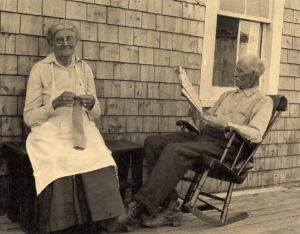
The singer was Bessie MacEachern; it was recorded in her home in 1971 by John Alick MacPherson. The song is in praise of Cape Breton and was composed by Jonathan MacKinnon (1869-1944).
Born in Whycocomagh, of Skye descent, he was the founder and editor of the weekly (latterly fortnightly) Gaelic newspaper Mac Talla from 1892 to 1904, and of the monthly publication Fear na Cèilidh, 1928-30. He also wrote local history, including a book called Old Sydney.
This recording is from a selection of tapes which were broadcast on the BBC and made by John Alick Macpherson (BBC Scotland) and Angus John Smith (Glasgow University) when they were in Cape Breton in 1971. They made their headquarters at Cape Bretoniana, which is now The Beaton Institute.
The song is alternately known as Òran Do Cheap Breatuinn (Song To Cape Breton).
Eilean Gorm Nam Beanntan Àrd, 1971. Bessie MacEachern. T-311. Beaton Institute, Cape Breton University.
Artist
Bessie MacEachern
Bessie MacEachern was born October 4, 1911 at Craigmore, Cape Breton. Her parents were Angus D. MacEachern of Craigmore and Katie Anne MacNeil of Iona, Nova Scotia. She married Alex Angus MacEachern of Creignish on July 24, 1934. They had two sons, Lawrence and Joseph.
Bessie sang at concerts and ceilidhs in Creignish, Judique, Port Hawkesbury, Southwest Margaree, Broad Cove, the Highland Village, Glendale, Lake Ainslie, and Antigonish, including the Highland Games. She was a participant in annual St. Andrew’s Day and Robbie Burns’s Day events. Bessie sang at the official opening of the Canso Causeway in Port Hastings on 13 August 1955 and also at the 25th Anniversary in 1980. She often sang with other Gaelic singers, including Fr. Donald Angus Rankin.
Bessie and Alex Angus taught Gaelic classes in Creignish between 1971 and 1973; she taught Gaelic songs while he taught Gaelic conversation and translations.
On July 29, 1972, Bessie participated in the Caidreabh project, singing at the “World’s Biggest Ceilidh” at the Centennial Arena in Sydney, Nova Scotia. She was also a founding member of Coisir an Eilean ,the Gaelic singing group, who performed at the Nova Scotia Tattoo (Halifax, 1983) and at Festival Antigonish’s An Evening With the Cape Breton Gaelic Choirs (1988).
In August 1989, Bessie attended and sang at the re-dedication of the Cille Choirill church in Glen Spean, Brae Lochaber, Scotland and at various places during a cultural trip of Cape Bretoners to Scotland, arranged by Mary Campbell and John S. MacIsaac.
Bessie died on September 10, 1996 and is buried in Creignish at the Stella Maris parish cemetery.
Lyrics
Eilean Gorm Nam Beanntan Àrd
Eilean gorm nam beanntan àrd,
Tìr mo dhùthchais, tìr mo ghràidh,
‘S iomadh tonn a bhuaileas tràigh
Mun iarr mi fàth air carachadh.
Tìr as àile tha fon ghrèin,
Cnoic is glinn is raointean rèidh,
Coille dhlùth nam mìle geug
‘S an cluinnear gleus air ceilearadh.
Monaidhean ‘s am faighear fèidh,
Aonaichean ‘s an cinnich sprèidh,
Fonn, ma chuirear e fon chlèith,
A thig fo dhèis le aran dhuinn.
Faodaidh gum bi ‘n geamhradh fuar,
‘S gaoth an earraich on taobh tuath,
Thig an samhradh blàth na uair
Le cur is buan gar toileachadh.
Anns a’ ghleann sa bheil sinn fhìn
Faighinn beatha ‘s teachd-an-tìr,
Chan eil deireas oirnn no dìth —
Chan eil an rìgh cho sona ruinn.
‘S ann tha ‘n sluagh tha ceanalt’, ciùin,
Siol nan sonn a b’àirde cliù,
‘S mòr leam fhìn gu bheil mi dhiubh,
Bu shuarach crùn a roghainn air.
Far an d’fhuair mi m’àrach òg,
Fanaidh mi le toil ‘s le deòin;
Air cho fad ‘s gum bi mi beò,
Cha dèan an t-òr mo mhealladh as.
Eilean gorm nam beanntan àrd,
Tìr mo dhùthchais, tìr mo ghràidh,
‘S iomadh tonn a bhuaileas tràigh
Mun iarr mi fàth air carachadh.
Translation:
Green Isle of the High Mountains
Green isle of the high mountains,
Land of my birth, land of my love,
Many waves will break on shore
Before I ever wish to leave.
Most beautiful land under the sun,
Knolls and glens and level plains,
Forests dense with thousands of branches,
Where you hear the melodies of bird-song.
Moorlands where you find deer,
Pastures where cattle flourish,
Soil which, when put under the harrow,
Will ripen to provide bread for us.
The winter might be cold
And also the north wind of spring,
But warm summer will come at last
With planting and reaping to make us happy.
In the glen where we ourselves
Have life and livelihood,
We have no shortage or dearth —
The king is not as happy as we are.
Here the folk are polite and sedate,
Seed of heroes of high renown;
I am proud to belong to them,
A crown would be paltry compared with it.
Where I was reared in my youth,
I will remain there willingly;
For as long as I live
No gold will entice me away from there.
Green isle of the high mountains,
Land of my birth, land of my love,
Many waves will break on shore
Before I ever wish to leave.